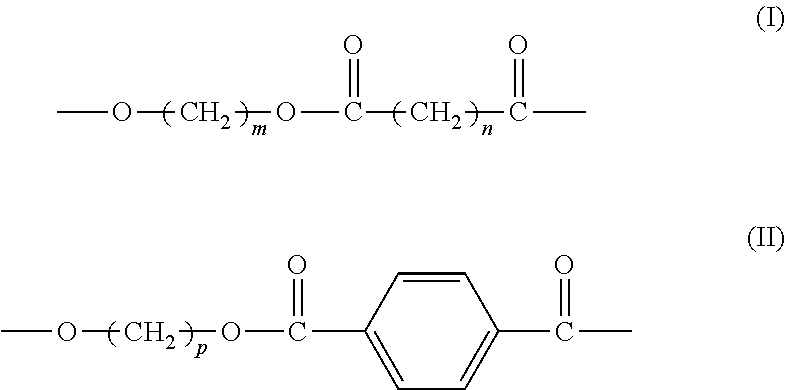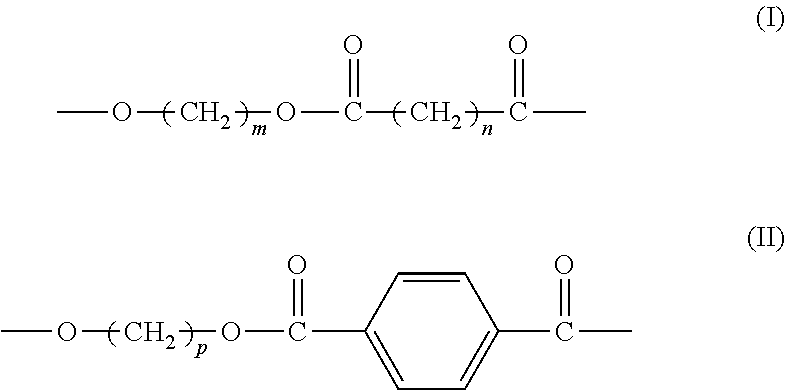Biodegradable Composite, The Preparation Process Thereof, And A Disposable Article Made Therefrom
- Summary
- Abstract
- Description
- Claims
- Application Information
AI Technical Summary
Benefits of technology
Problems solved by technology
Method used
Image
Examples
example 1
[0059](1) Preparation of Aliphatic-Aromatic Copolyester (i.e. Aliphatic-Aromatic Copolyester A)
[0060]Catalyst: based on the total weight of the catalyst, the catalyst comprises 57.8% by weight of lanthanum stearate (prepared according to the process in Example AS of CN 1807485A), 23.2% by weight of tetrabutyl titaniate (purchased from Beijing Chemicals Co.), 10.0% by weight of dibutyltin oxide (purchased from Beijing Third Chemical Plant), and 9.0% by weight of triphenylhydroxy tin (purchased from Beijing Chemicals Co.).
[0061]1.72 mol p-phthalic acid (285.2 g), 2.78 mol 1,4-butylene glycol, and 1.058 g aforesaid catalyst were added to a 2.5 L reactor, which was heated while stirring in an atmosphere of nitrogen until reflux took place. The temperature was adjusted to 230° C. and the reaction proceeded at this temperature for about 100 min. When the water formed in the reaction was completely vaporized, 1.86 mol 1,4-succinic acid (220 g), 2.22 mol 1,4-butanediol, and 1.3 g pentacryth...
example 2
[0064](1) Preparation of Aliphatic-Aromatic Copolyester (i.e. Aliphatic-Aromatic Copolyester A)
[0065]Catalyst: based on the total weight, the catalyst comprises 57.8% by weight of lanthanum stearate (prepared according to the process in Example AS of CN 1807485A), 23.2% by weight of tetrabutyl titaniate (purchased from Beijing Chemicals Co.), 10.0% by weight of dibutyltin oxide (purchased from Beijing Third Chemical Plant), and 9.0% by weight of triphenylhydroxy tin (purchased from Beijing Chemicals Co.).
[0066]0.72 mol p-phthalic acid (119.5 g), 1 mol dimethyl phthalate (194.2 g), 2.55 mol 1,3-propylene glycol, and 1.058 g aforesaid catalyst were added to a 2.5 L reactor, which was heated while stirring in an atmosphere of nitrogen until reflux took place. The temperature was adjusted to 230° C. and the reaction proceeded at this temperature for about 100 min. When the water produced in the reaction was completely vaporized, 1.38 mol 1,6-adipic acid (201.5 g), 2.10 mol 1,3-propylene...
example 3
(1) Preparation of Aliphatic-Aromatic Copolyester (e.g., Aliphatic-Aromatic Copolyester A)
[0069]Catalyst: based on the total weight of the catalyst, the catalyst comprises 57.8% by weight of lanthanum stearate (prepared according to the process in Example A5 of CN 1807485A), 23.2% by weight of tetrabutyl titaniate (purchased from Beijing Chemicals Co.), 10.0% by weight of dibutyltin oxide (purchased from Beijing Third Chemical Plant), and 9.0% by weight of triphenylhydroxy tin (purchased from Beijing Chemicals Co.).
[0070]2 mol p-phthalic acid (332 g), 1.8 mol 1,4-butylene glycol, and 1.058 g aforesaid catalyst were added to a 2.5 L reactor, which were heated while stirring in an atmosphere of nitrogen until reflux took place. The temperature was adjusted to 230° C. and the reaction proceeded at this temperature for about 100 min. When the water produced in the reaction was completely vaporized, 2.5 mol 1,3-propane diacid (260 g), 1.8 mol 1,4-butylene glycol, and 2.0 g hydoxysuccinic...
PUM
| Property | Measurement | Unit |
|---|---|---|
| Temperature | aaaaa | aaaaa |
| Temperature | aaaaa | aaaaa |
| Temperature | aaaaa | aaaaa |
Abstract
Description
Claims
Application Information
 Login to View More
Login to View More - R&D
- Intellectual Property
- Life Sciences
- Materials
- Tech Scout
- Unparalleled Data Quality
- Higher Quality Content
- 60% Fewer Hallucinations
Browse by: Latest US Patents, China's latest patents, Technical Efficacy Thesaurus, Application Domain, Technology Topic, Popular Technical Reports.
© 2025 PatSnap. All rights reserved.Legal|Privacy policy|Modern Slavery Act Transparency Statement|Sitemap|About US| Contact US: help@patsnap.com



